The Works Progress Administration, founded in 1935 as part of FDR’s New Deal, set out to document American culture. The methods that they used to record the folk vary from spoken interviews, songs, photographs, written interviews, and state guides.
As part of the Federal One project the Federal Writers Project was tasked with reaching out and recording the stories of the American people.
The FWP was managed at both the state and federal levels. John Lomax was a folklore editor and in March 1939, he and his wife Ruby set out on a journey that would traverse 6500 miles across the southern states. 1

They made recordings of folksong of all kinds, ballads, cowboy songs, fiddle tunes, lullabies, and many more. In all there were more than 25 hours from over 300 different performers, all with their own unique story to tell and culture to represent. 3
In addition to folksongs they recorded sermons like the one in Houston, Texas, April 12, 1939 by John Lowry Goree. 4
John Lomax was not the only FWP contributor to take to the open road. In the 1930’s Sidney Robertson Cowell was one of the folk music collectors associated with the Northern California WPA. She was perhaps the greatest activist in California when it came to collecting and documents the migrant experience. She interviewed and recorded the culture and songs of immigrants and their families. 5
As part of her collection Cowell also took still photographs of the people she chronicled. Her endeavor was “ one of the earliest ethnographic field projects to document European, Slavic, Middle Eastern, and English- and Spanish-language folk music in one region of the United States”. 6

In addition to the FWP other Federal One Projects documented the American folk. The Federal Music Project and Farm Security Administration also fell under the Works Progress Administration. 8
The Federal Music Project was regionally managed and really showed the distinctiveness of the different parts of the US. This was vital, the southern hymnals were very different from the migrant songs of the people in Northern California. Just as the people were distinct so too was their music. 9
One project took place in the Federal Music Project Office, Jacksonville, Florida. The performer, Zora Neale Hurston sang a number of songs that helped to document the way that music featured in the culture and work of slaves. 10 Many of them are “work” songs, their beats keep time for the task they are doing. The music that the FMP recorded is a treasury of folklore, some telling stories and others long traditions from generations past.
The Farm Security Administration took more than 270,000 photographs during its effort to document the trials and tribulations of the American people across the country. The famous Migrant Mother image taken by Dorothea Lange is part of this collection. It shows the lives of the people displaced by the Dust Bowl and downtrodden from the Great Depression. It documents the many camps that sprung up and the people that lived there. The very people that the New Deal set out to help. These photos are perhaps the best record of how the New Deal was helping people.

Throughout the New Deal era the Works Progress Administration sought to define the American people. What they did was document just how much of a “melting pot” the United States really is. Through the recording of local music, written interviews, and thousands of photographs the Federal One project illustrated the unique and engaging American Folk.
- Library of Congress. Southern Mosaic: The John and Ruby Lomax 1939 Southern States Recording Trip. “Introduction” Accessed 11/20/2019. https://www.loc.gov/collections/john-and-ruby-lomax/about-this-collection/
- John A. Lomax, Jr. standing next to car, facing front
. , None. [Between 1930 and 1950] Photograph. https://www.loc.gov/item/2007660354/ - “Waitin’ on You”.Southern Mosaic: The John and Ruby Lomax 1939 Southern States Recording Trip. Library of Congress https://www.loc.gov/item/lomaxbib000378/.
- “Negro Sermon”. Southern Mosaic: The John and Ruby Lomax 1939 Southern States Recording Trip. Library of Congress.https://www.loc.gov/item/lomaxbib000023/
- “The Drunkard’s child”.California Gold: Northern California Folk Music from the Thirties Collected by Sidney Robertson Cowell .Library of Congress https://www.loc.gov/item/2017655315/
- Library of Congress. “California Gold: Northern California Folk Music from the Thirties Collected by Sidney Robertson Cowell” Accessed 11/20/2019. https://www.loc.gov/collections/sidney-robertson-cowell-northern-california-folk-music/about-this-collection/
- Cowell, Sidney Robertson, Collector. Russian Molokan congregation, Potrero Hill, San Francisco, California, group portrait, photograph. California San Francisco, 1938. Photograph. https://www.loc.gov/item/2017701287/.
- Library of Congress.“WPA Publications in the Library Collections”. Accessed 11/20/2019. https://www.loc.gov/collections/federal-theatre-project-1935-to-1939/articles-and-essays/amassing-american-stuff/wpa-publications-in-the-library-collections/
- GOUGH, PETER, and Peggy Seeger. “Introduction.” In Sounds of the New Deal: The Federal Music Project in the West, 1-9. University of Illinois Press, 2015. www.jstor.org/stable/10.5406/j.ctt130jtfw.5.
- “Dat Old Black Gal”. Herbert Halpert 1939 Southern States Recording Expedition. Library of Congress. https://www.loc.gov/item/flwpa000005/
- Lange, Dorothea, photographer. Destitute pea pickers in California. Mother of seven children. Age thirty-two. Nipomo, California. California Nipomo Nipomo. San Luis Obispo County United States, 1936. March. Photograph. https://www.loc.gov/item/2017762891/.
